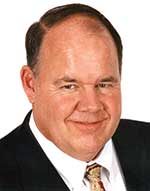Speaker Spotlight: The magic of sharing safety with others

EDITOR’S NOTE: Every year, the National Safety Council Congress & Expo features some of the top thought-leaders and motivators in the occupational safety and health community. Safety+Health has invited the most highly rated presenters to contribute to this monthly column. For more on this year’s event, visit congress.nsc.org.
Sadly, many injuries occur every day in which someone other than the injured party had seen the unsafe condition or behavior prior to the incident. Often immediately before the incident, someone watched the person near a hazard or doing something unsafe and, tragically, chose to say nothing.
One of the most common reasons why people don’t intercede or share safety with someone else is they believe or convince themselves that nothing is going to happen. For instance, you and I could be eating lunch at a restaurant and see one of the staff using a chair as a stepladder to change a light bulb. We know that it isn’t safe, but it’s easy to not say anything or offer assistance because of our life experiences. I have seen many people using a chair as a stepladder; however, I have never seen someone fall off the chair doing so. That allows me to feel comfortable to not share safety with the person at risk.
How, then, do we give people the self-motivation to take action and help others live safely?
One of five reasons
The solution is to give yourself and others a good reason to intervene. When someone has a good-enough emotionally based reason, they’re likely to take action. In my employee presentations and one of my books, I give people at least five powerful reasons why they would want to watch out for the safety of others.
The key is to motivate them to “want to.” When people want to do something, you know they’ll do it even when no one is watching. That’s because the motivation comes from within themselves.
One of those five reasons is avoiding regret. I’ve interviewed people who could have stepped in and saved a life and didn’t. I can assure you they feel a pain and regret that never goes away.
I teach that if you ever find yourself observing an unsafe condition or behavior, ask yourself, “How would I feel if something did go wrong and the person was injured?” If the answer is that you would feel bad, then protect yourself from regret and talk to the person.
Keep everyone in the interaction comfortable
It’s also crucial to make such an intervention comfortable for the person helping and the person being helped. We as human beings will do quite a bit to avoid feeling discomfort. It can be uncomfortable to point out a hazard or unsafe behavior to someone.
The solution is to use techniques that make both the person sharing safety and the recipient of that caring act feel good. One technique I teach is to ask the question, “Would you like me to watch out for your safety?”
Just like the magic I have performed in my presentations over the past 29 years, there’s a trick to it. This question is designed to cultivate a “yes” answer because it creates curiosity on the part of the listener. Once the natural answer is given, he or she has given the helping party permission to share safety. This allows both parties to feel good about the conversation.
Imagine the number of injuries that will be prevented when everyone in your workforce feels comfortable enough and has the skills necessary to share safety with anyone on and off the job.
This article represents the views of the author and should not be construed as a National Safety Council endorsement.
 John Drebinger has provided effective and entertaining presentations for 29 years. He is the author of two best-selling books, “Mastering Safety Communication” and “Would You Watch Out for My Safety?” Drebinger also is a professional member of the American Society of Safety Professionals. To help your employees watch out for each other, visit drebinger.com, call (209) 745-9419 or email [email protected].
John Drebinger has provided effective and entertaining presentations for 29 years. He is the author of two best-selling books, “Mastering Safety Communication” and “Would You Watch Out for My Safety?” Drebinger also is a professional member of the American Society of Safety Professionals. To help your employees watch out for each other, visit drebinger.com, call (209) 745-9419 or email [email protected].
Direct to your inbox: Sign up to be notified in email about new Speaker Spotlight columns.
Post a comment to this article
Safety+Health welcomes comments that promote respectful dialogue. Please stay on topic. Comments that contain personal attacks, profanity or abusive language – or those aggressively promoting products or services – will be removed. We reserve the right to determine which comments violate our comment policy. (Anonymous comments are welcome; merely skip the “name” field in the comment box. An email address is required but will not be included with your comment.)

